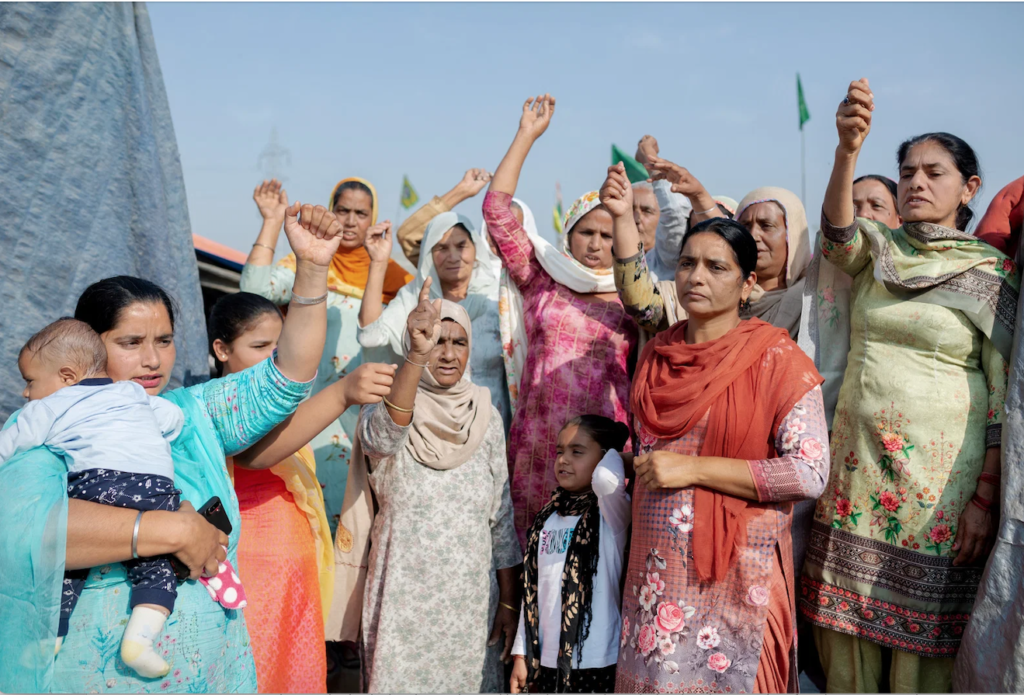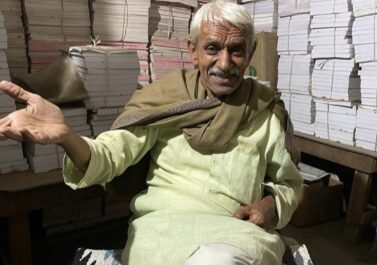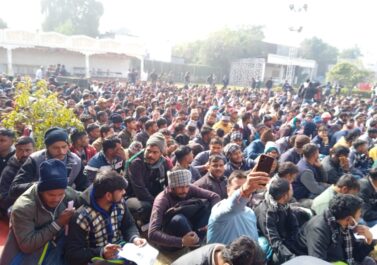
We recently had an interesting meeting with comrades from India about the farmers’ movement, the Covid pandemic and the impact on workers’ struggles. Comrades spoke briefly about the historical development of the ‘peasant movements’ in India as the context of which to make sense of recent struggles. While the traditional peasant movement of the early 20th century up to the 1960s demanded land reforms and land redistribution, the ‘New Farmers’ Movement’ from the 1970s onwards focused on the question of subsidies and market prices, access and protection. Many organisations of the ‘New Farmers Movement’ opposed minimum wage increases for agricultural workers. The current movement, although about a legal market reform, was led by smaller farmers, often referring to workers and their situation. While the second Covid wave has put a halt to the mass protests in Delhi, local actions continue. Many villages engage in boycotts, e.g. by not paying electricity bills or cooperationg with the administration. In Punjab, many highway toll stations are occupied by local farming villages, letting traffic through for free, in order to exert more economic pressure on the government. These occupations are organised in rotation. Unlike in the 1970s, the government haven’t managed to ‘regionalise’ the farmers’ movement. In the 1970s the government supported Sikh fundamentalism against the radical ‘left-wing’ rural movements and later on against more moderate ‘Punjabi independence’ parties – this tactic ended up in religious-nationalist massacres. Despite the attempt to reduce the farmers’ movement to a ‘Punjabi affair’ the mobilisation has crossed state boundaries.
The question is whether the new laws, which further open the agricultural market are a sign of weakness or strength of the state. The ‘mandis’, the state regulated institutions which oversee and conduct the buying of agricultural produce are an important – and corrupted – bridge organisation between the state and the rural agricultural class of farmers. They are a sensor and pressure valve, they can be used as vote banks and for economic planning. The same is true for government-run agencies, which sell subsidised food stuff to the ‘official poor’. With these agencies the state has a foot and ear in thousands of slums and poor villages. Giving access to subsidised food means being able to have significant control over millions of poor proletarians. But both these state institutions are expensive. In that sense, the decision of the state to undermine these institutions are a sign of weakness – a lack of financial means to afford these organisations of social control.
When it comes to the Covid pandemic, we’ve seen over 200 local riots of primarily migrant workers during the first wave. These were actions against severe state measures, the police control, the cancellation of trains back to the villages. As a result, the state has been much more hands off during the second wave. The central government has lost a lot of trust, while it depends on their ‘Covid performance’ whether people still back their regional governments, e.g. during recent elections. In the end, it still largely depends on workers to enforce health measures. There have been numerous (unofficial) strikes of health workers to enforce better resources and working conditions. Hyundai car workers recently enforced the temporary shutting down of their plant in response to Covid cases. At the moment there are about 20 to 25 % less migrant workers in the major industrial centres, which causes a (temporary) wage pressure from below. Overall, though, and similar to the situation in China, the offensive workers’ struggles, which started in the mid-2000s, peaked in 2011 to 2014 and have been on the backfoot since the economic downturn started. Many actions now concern the payment of delayed wages and the compensation for lay-offs, such as during the factory occupation at Honda by temporary workers. During the farmers protests, groups of factory workers in Delhi protested in front of their factories, but were brutally attacked by private security and then the police. A comrade of ours has conducted many interviews with industrial workers during and after Covid – we document them here.
Many workers feel the squeeze from both sides: since the onset of the crisis in 2016 industrial jobs have become more precarious; and the new law makes farmers’ incomes more precarious (many workers are still connected to the rural world). The Covid crisis and the temporary push from the urban back to the rural has made this squeeze visible for everyone. No wonder that the government has postponed the legal reform – seeing that there is a big risk that the ‘farmers’ movement would further infect the wider urban working class.
As we have seen, the ‘privatisation’ of the food and agricultural sector gets rid of certain institutions of social control. This only adds to a general disconnect between ‘state’ and working class. Overall, we can say that the big bulk of workers in India have little connection to political ‘civil society’ and traditional forms of organisation, due to their migrant status. A comrade presented the following thoughts on this issue…
————
A little bit about us. We run a blog called “Kaam Se Chhutti” (variously translated as Holiday from Work, Leaving from Work, or Getting Fired from Work), which regularly publishes articles about (but not limited to) workers in organized production-distribution in South Asia. We have been associated with Faridabad Mazdoor Samachar in the past and continue to be in regular engagement with them. Manibhushan ji is active in the Delhi NCR as a member of the Revolutionary Socialist Party of India (ML). There are a number of other comrades too who are in regular touch from their respective workplace vantage points.
This piece attempts to speak about the social, political, and economic condition in India from the point of view of the working class. To begin with, it must be said that for the past several years, except a very small number, most of the workers of India are invisible from social, political, economic life and social discourse. This is sometimes referred to as the “informalisation of labor,” which is incorrect. Calling it informalisation creates an impression that this is some unnatural and despicable act on the part of the ruling class, and subsequently leads people to bark up the wrong trees of formalising and official accountability, whereas it is the most obvious part of 21st century capitalist expansion. Therefore we suggest it should be seen as the “invisibilisation of labor.”
Much of the literature on labour and its relation to production presumes the 20th century framework of legal intervention, tripartite negotiation, factory acts, labour laws, working conditions, etc. These frameworks emerged in a specific time with specific goals for the ruling classes in advanced capitalist countries, namely to create buffers to check rising working class revolt. In former colonies like India, such frameworks worked towards the expansion of stable wage-labour based urban systems in a predominantly peasant-artisan dominated area, with the lure of permanent (often government sector) jobs with regular, progressively increasing salaries. But today when the context has changed, capital has already adopted new means. Today when 90% of the workers are temporary, who while producing for the company are not workers of the company, who are given breaks from time to time, or whose work is of a “there may be no tomorrow” character – in this context these 20th century perspectives do not reflect either the needs of the workers nor the dominant tactics of capital.
Invisibility of the Working Class – 1
Firstly, by this we mean that today there is no such political party or social organization which advances any program which works for most of the (temporary) workers. At the present moment, there is no such program. It also means that most of the workers have nothing to do with the political processes and campaigns nationwide.
For example, we have shown in an article from a year ago how the majority of workers have no political rights in the area of their work.
“Surat is a city where 58% of the population is of migrants, i.e., migrants exceed the local population. 70% of the workers there are not local. Yet 98% of the workers have never met or spoken to any government official.”
Similar is the situation in all the cities where people come to work, but for most of the cities there is no data on how many people live there who do not have the right to vote. This gives immediate relief to the landlord-contractor class of these cities, who often dominate local and regional politics. At the same time, this situation also helps in keeping the salaries of the workers low, because the workers no longer think of permanent residence and sufficient spending in the city. On the other hand, this also means that the workers can pack up without paying the rent for a month or two, and at the same time the worker can leave their job anytime they like without worrying about losing something precious.
But if we look at this situation in its broader aspect, two things emerge from it. The first is that an increasing number of workers talk at a very professional, direct level with employers, landlords, etc. Dependence on middlemen or affiliations on the basis of village-religion-caste etc. are getting weaker, and this is particularly visible in the more global production centres (and among the more heavily proletarianised sections of the population). Getting some govt. official, policeman, or local musclemen involved in their matters usually works against the workers’ interests. So workers adopt a frugal professionalism with respect to other people.
The second thing, which is perhaps related to this, is that the workers do not become part of such political campaigns at the place of migration which have nothing to offer them. We have many recent examples of this before us.
The non-interest of the workers was clearly visible in the anti-CAA movement that took place in 2019 and the farming agitation that began in 2020 and still continues. The demands of both these movements have no place for most of the (temporary) workers.
Our experience in Delhi suggests that, despite workers’ settlements and factories being close to the site of the anti-CAA movement, migrant workers took part in these movements in very small numbers. Workers who come and live on rent in Delhi are already without any benefits from political rights. There are large communities of migrant Nepalese workers around Delhi NCR. Their absence was visible from the anti-CAA movement. If we consider the economic composition of the Delhi NCR region, then the violence in North East Delhi is not difficult to understand. The importance of religion, caste, etc. is still intact in the communities settled in North Eastern Delhi for one or two generations. Unlike cities like Gurgaon-Faridabad-Noida, small-scale or household industries are more predominant here, and the place has seen de-industrialisation. This helps us to understand why neither anti-CAA movement nor Hindu-Muslim violence spread in places like Gurgaon-Faridabad-Noida.
At the same time, in 2021, when the workers started returning home in the second wave of the COVID-19 epidemic, there was a call from the agitating farmers settled on the Delhi border for workers to join their demonstration instead of going home. Many friends have mentioned that there is a lot of discussion among the factory workers in Delhi and surrounding areas regarding the farmers’ movement. This is important. During the beginning of the peasant movement, some organizations had also tried to organize the workers alongside the farmers on the issues of wages. But in spite of all this, the workers of Delhi did not join the farmers’ agitations. This may be explained, again, by the consideration of what could the workers gain from doing this. Why, at this juncture, wage-workers in organised production are not gathering around any demands is a very important question we must ask.
In this scenario, at least, the situation of the workers was not like that of the landless “farmers” of Maharashtra who came to Delhi to join the farmers’ movement to seek claims on lands. For the past several years, under the Forest Rights Act (2006), agricultural laborers in the state of Maharashtra have been campaigning to get legal rights on portions of land, maybe 5-10 acres big. Their groups are often led by the All India Kisan Sabha, a party of land-owning farmers, which even helps to organize one-day rallies in big cities like Bombay-Nagpur etc. Before the events of 26th January, 2021 in Delhi, some groups of farmers from Maharashtra (both landholding and landless) also reached Bombay to stage a sit-in outside the collector’s office and the head office of Reliance Industries, which are adjacent. The peasant parties asked them to withdraw from there and to extend support to the agitating farmers based in Delhi. It is clear that the demands being raised are limited to, firstly, a question of how to determine the price of farm produce, and secondly, a political question of BJP versus anti-BJP. The class questions have clearly not opened up yet.
On the other hand, it did not take long for the working class to become a massive organized force when the Indian government announced a nationwide lockdown in 2020 last year (see endnote i). Within a week, groups of laborers came out on the road from place to place, first making humble appeals that they should be allowed to go home, and then unleashing nationwide fury in the face of political silence and repression. Its impact was so strong that not only did the government’s announced lockdown tear into shreds, but the government severely reconsidered imposing any restrictions on movement during the second wave in 2021. This is a classic assertion of the politically free character of wage-labour.
Invisibility of the Working Class – 2
Secondly, the invisibilisation of workers also operates through the domination of the middle classes. Since temporary contracts and just in time production is at the heart of the present organisation of labour, even the opposition from the workers’ side is broken in time and place. This applies equally to the workers engaged in garment and auto production hired by the contractor as to the “associate” of Swiggy-Zomato-Uber-Ola-Amazon. Rather than seeing this as a characteristic of Indian capitalism (since there is no such thing), it ought to be seen as a consequence of post-90s expansion of global capitalism.
In the past thirty years, workers in South Asia have become more integrated into the global market than ever before. This can be estimated from the fact that while India’s global exports in 2000 were US$ 60 billion (and 13% of GDP), today this export is US$ 528 billion (and 19 per cent of GDP).6 On the one hand, while this change has further accelerated social changes, and increased production has brought about many political and cultural changes, two things still persist despite these changes: 1) the domination of an urban upper-middle class in politics and 2) the demand by this middle class to further strengthen the state machinery. It is just the middle class calling out for a harsher state, more degenerate political parties, as they have always done, particularly in times of crisis. This should not be confused with fascism, doing which ignores the history of political repression in pre-BJP India. Certainly, the character of the middle class itself has changed immensely, with the Indian middle-classes filling in roles for multi-national companies at globally lower wages, and subsequent expansion of fields like software, design, accounts and finance, content creation, managerial positions, and so on.
The “middle class” itself is replete with hierarchies. According to the McKinsey global organization, people earning between the bracket 2 lakh to 20 lakh rupees fall in the middle class. According to a report by Hurun India, the number of households earning 40 lakhs (and accumulating assets of Rs 5-7 crores) has increased very rapidly in the last 20 years in India. They call this section the “new middle class.” There is no clarity about what the middle class is. It is amorphous, and perhaps the major factor which distinguishes it is that it lives somewhat comfortably over and above the minimum wages bracket. And that it is aligned with the status quo ideologically.
21st Century Capitalism and Workers
A middle-class dominant capitalism driven by consumption creates very specific kinds of problems. Since the global crisis of 2008, the process of profiting from investment has taken on a feverish pace. It has brought to the fore extreme corruption of the ruling classes as well as a mindless exploitation of nature. For example, Indian cities have recorded more pollution than those in China, despite producing a fraction of what is produced in China.
There are a number of such specificities when it comes to India, and it often becomes a problem for the expansion of capital itself. According to a report in the Wall-Street Journal, about 50% of the workers in India are employed in the supply-chain, and a very small section of these work on modern machines (such as forklifts, etc.). That is, most of the supply-chain workers pull and lift by bare hands, cycles, older technologies, animal labour, or cheap machinery. On the one hand, there has been a considerable improvement in the machinery for production, for greater output; on the other, storage and supply mechanisms are still very primitive. The result of this was seen well in the aftermath of the first Covid lockdown, when the movement of goods came to a standstill in many parts of the country and even brought production to a halt. If India’s managerial/ruling class is so lax on the issue of supply-chains – and this includes the various governments of India, which have so far been in control of supply-chains in agriculture – it spends even lesser in the form of wages for workers. In this situation, the back-and-forth which workers do between place of work and place of residence has been going on from before; but the Covid-19 pandemic made this back-and-forth visible. The result now is extremely rickety production cycles, and widespread labor-shortage in big cities like Delhi-Chennai-Bangalore, where there are reported to be 20-30% fewer workers left, and as per some reports the averge daily wage has increased in certain parts.
It is natural that in this process the lower sections of the middle classes are also being pushed to the brink everyday. The security cover provided by 20th century welfare Keynsianism is almost done for. Based on these shifts, many nationalist and identitarian movements emerge, but with rather small life-spans. The hit-and-miss game of the ruling classes is likely to go on indefinitely, going by current trends. It is possible that sections of the middle class might also turn towards a more class conscious politics.
The questions before the working class immediately are – 1) their increasingly becoming rendered surplus population, and the increasingly temporary nature of work, and 2) the urgent need to negate the managerial class’ habit to stick to primitive means and to push down wages. Not only does direct-action on part of the working class reflect these concerns, it could also lead to radical shifts. And at the same time, the rapid destruction of nature under the leadership of the ruling classes also stares us in the face.



